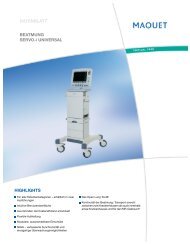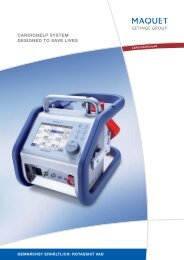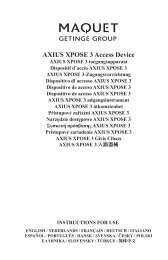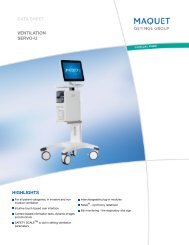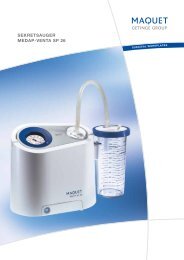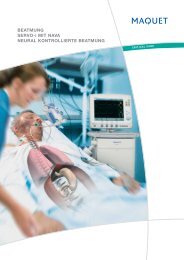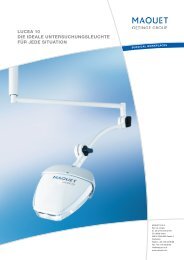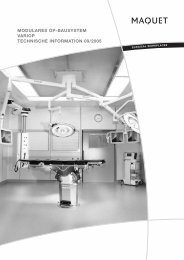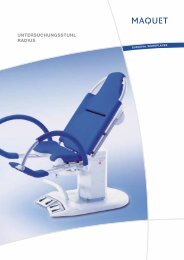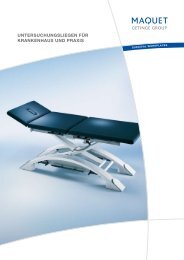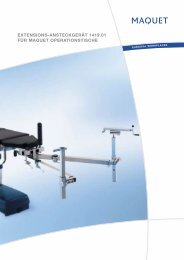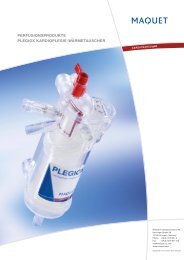challenges in critical care: geisinger medical center - Maquet
challenges in critical care: geisinger medical center - Maquet
challenges in critical care: geisinger medical center - Maquet
You also want an ePaper? Increase the reach of your titles
YUMPU automatically turns print PDFs into web optimized ePapers that Google loves.
| 6 | Geis<strong>in</strong>ger Hospital | Critical Care |<br />
Guidel<strong>in</strong>es:<br />
NPPV (Non-Invasive Positive Pressure Ventilation)<br />
1. Initiation of NPPV<br />
a. In conjunction with section B:<br />
Patient Assessment, a spontaneously breath<strong>in</strong>g patient<br />
with two of the follow<strong>in</strong>g criteria may be a candidate<br />
for NPPV:<br />
1. dyspnea<br />
2. accessory muscle use<br />
3. SaO < 90%<br />
4. respiratory rate > 24 BPM<br />
b. A patient with the follow<strong>in</strong>g is not a candidate for NPPV:<br />
1. respiratory arrest<br />
2. uncontrolled arrhythmia<br />
3. airway obstruction<br />
4. <strong>in</strong>ability to clear secretions<br />
5. coma, uncooperative or claustrophobia<br />
6. facial trauma<br />
7. hypotension with systolic blood pressure<br />
< 90 mmHg<br />
c. Initial sett<strong>in</strong>gs <strong>in</strong>clude:<br />
1. NIV-Pressure Support<br />
2. Pressure Support Level = 10cmh20<br />
3. PEEP = 4 cmh20<br />
4. backup rate=8 BPM<br />
5. <strong>in</strong>spiratory rise adjusted to patient comfort.<br />
Note: A comfortable, properly fitt<strong>in</strong>g mask should be chosen, too.<br />
d. To adjust for optimal ventilation, <strong>in</strong>crease PS <strong>in</strong> <strong>in</strong>crements<br />
of 2 cm H2O to relieve respiratory distress, and to adjust for<br />
<strong>in</strong>adequate oxygenation, <strong>in</strong>crease PEEP (<strong>in</strong> <strong>in</strong>crements of 2 cm<br />
H2O) and/or FiO to achieve SaO > 92%. Note: Increases <strong>in</strong> PEEP<br />
will decrease PS. Therefore, PS may have to be <strong>in</strong>creased to<br />
ma<strong>in</strong>ta<strong>in</strong> desired ventilation.<br />
2. Discont<strong>in</strong>uation of NPPV<br />
a. When precipitat<strong>in</strong>g cause(s) of respiratory failure is/are sufficiently resolved, when m<strong>in</strong>imal NIV support (PS and PEEP) pressures are<br />
needed to ma<strong>in</strong>ta<strong>in</strong> adequate patient comfort without signs/symptoms of respiratory distress, and when FiO < 65%, a trial off NPPV<br />
can be <strong>in</strong>itiated. Note: M<strong>in</strong>imal NIV support pressures are: PS = 10 cm H2O and PEEP=4 cm H2O. The views, op<strong>in</strong>ions, and assertions stated by Geis<strong>in</strong>ger Medical<br />
Center staff members <strong>in</strong> this article are strictly those of the<br />
cl<strong>in</strong>icians and adm<strong>in</strong>istrators, and do not necessarily reflect the<br />
views of MAQUET.



